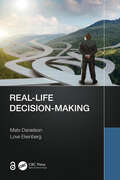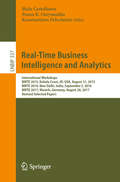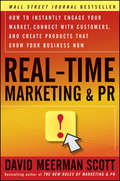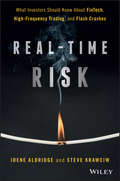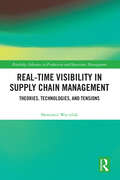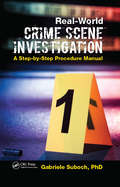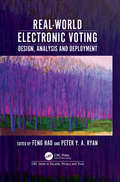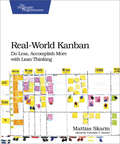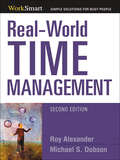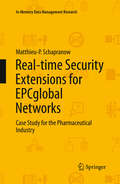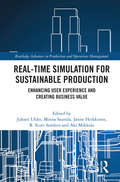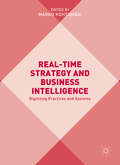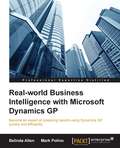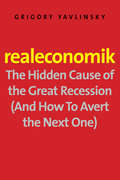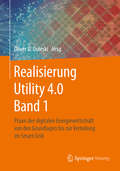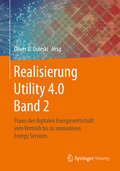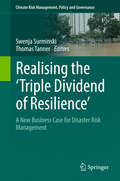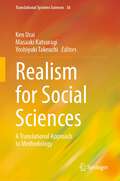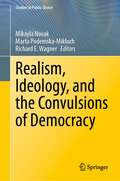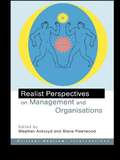- Table View
- List View
Real and Financial Sectors in Post-Pandemic Central and Eastern Europe: The Impact of Economic, Monetary, and Fiscal Policy (Contributions to Economics)
by Bojana Olgić Draženović Vesna Buterin Stella Suljić NikolajThis book offers new insights into the real and financial sectors in the post-pandemic European Union, with a specific focus on the countries of Central and Eastern Europe and a special reference to Croatia. The contributors examine the timeliness, justification, and appropriateness of the measures taken in response to the deteriorating economic conditions and the associated outcomes. They further discuss various aspects of economic, financial, and energy policy. While doing so, they focus on two important issues. The first is an analysis and assessment of the financial development and performance of the real sector. The second is an insight into the institutional dimensions of the COVID-19 pandemic, including the discussion of obstacles and opportunities for recovery in the near future. The topics covered in this book include, but are not limited to, unconventional monetary policy, financial cycles, fiscal incentives, institutional development and institutional quality, the banking system, real estate markets, competitiveness, pension systems, financial regulation, energy markets, environmental, social, and governance (ESG) factors, as well as agricultural policy. Therefore, this volume will appeal to researchers, students, and scholars of finance and economics, as well as policy-makers interested in a better understanding of real and financial sectors, economic policy, and post-pandemic economic development in Central and Eastern Europe.
Real traders II
by Eva DiazThe follow-up to Real Traders, Real Lives, Real Money, this book explains how a landscape gardener turned full-time trader transformed $32 000 into $110 000 in nine weeks trading contracts for difference (CFDs). Other top Australian traders' secrets for making profi table returns from CFD trading are also shared, including their trading strategies and tactics, trading routines and psychology, tips, mistakes and lessons learnt.
Real-Life Decision-Making
by Love Ekenberg Mats DanielsonHave you ever experienced a decision situation that was hard to come to grips with? Did you ever feel a need to improve your decision-making skills? Is this something where you feel that you have not learned enough practical and useful methods? In that case, you are not alone! Even though decision-making is both considered and actually is a very important skill in modern work-life as well as in private life, these skills are not to any reasonable extent taught in schools at any level. No wonder many people do indeed feel the need to improve but have a hard time finding out how. This book is an attempt to remedy this shortcoming of our educational systems and possibly also of our common, partly intuition-based, decision culture. Intuition is not at all bad, quite the contrary, but it has to co-exist with rationality. We will show you how.Methods for decision-making should be of prime concern to any individual or organisation, even if the decision processes are not always explicitly or even consciously formulated. All kinds of organisations, as well as individuals, must continuously make decisions of the most varied nature in order to prosper and attain their objectives. A large part of the time spent in any organisation, not least at management levels, is spent gathering, processing, and compiling information for the purpose of making decisions supported by that information. The same interest has hitherto not been shown for individual decision-making, even though large gains would also be obtained at a personal level if important personal decisions were better deliberated. This book aims at changing that and thus attends to both categories of decision-makers.This book will take you through a journey starting with some history of decision-making and analysis and then go through easy-to-learn ways of structuring decision information and methods for analysing the decision situations, beginning with simple decision situations and then moving on to progressively harder ones, but never losing sight of the overarching goal that the reader should be able to follow the progression and being able to carry out similar decision analyses in real-life situations.The Open Access version of this book, available at www.taylorfrancis.com, has been made available under a Creative Commons Attribution-Non Commercial-No Derivatives 4.0 license.
Real-Time Business Intelligence and Analytics: International Workshops, BIRTE 2015, Kohala Coast, HI, USA, August 31, 2015, BIRTE 2016, New Delhi, India, September 5, 2016, BIRTE 2017, Munich, Germany, August 28, 2017, Revised Selected Papers (Lecture Notes in Business Information Processing #337)
by Malu Castellanos Panos K. Chrysanthis Konstantinos PelechrinisThis book constitutes the thoroughly refereed conference proceedings of the BIRTE workshops listed below, which were held in in conjunction with VLDB, the International Conference on Very Large Data Bases: 9th International Workshop on Business Intelligence for the Real-Time Enterprise, BIRTE 2015, held in Kohala Coast, Hawaii, in August 2015, 10th International Workshop on Enabling Real-Time Business Intelligence, BIRTE 2016, held in New Delhi, India, in September 2016,11th International Workshop on Real-Time Business Intelligence and Analytics, BIRTE 2017, held in Munich, Germany, in August 2017. The BIRTE workshop series provides a forum for the discussion and advancement of the science and engineering enabling real-time business intelligence and the novel applications that build on these foundational techniques.The book includes five selected papers from BIRTE 2015; five selected papers from BIRTE 2016; and three selected papers from BIRTE 2017.
Real-Time Marketing and PR
by David Meerman ScottLaunch effective real-time communications to win in today's always-on worldGone are the days when you could plan out your marketing and public relations programs well in advance and release them on your timetable. "Real time" means news breaks over minutes, not days. It means companies develop (or refine) products or services instantly, based on feedback from customers or events in the marketplace. And it's when businesses see an opportunity and are the first to act on it. In this eye-opening follow-up to The New Rules of Marketing and PR, a BusinessWeek bestseller, David Meerman Scott reveals the proven, practical steps to take your business into the real-time era.Find out how to act and react flexibly as events occur, position your brand in the always-on world of the Web, and avoid embarrassing mistakes and missteps. Real-Time Marketing and PR will also enable you to:Develop a business culture that encourages speed over slothRead buying signals as people interact with your online informationCrowdsource product development, naming, and even marketing materials such as online videosEngage reporters to shape stories as they are being writtenCommand premium prices by delivering products at speedDeploy technology to listen in on millions of online discussions and instantly engage with customers and buyersScale and media buying power are no longer a decisive advantage. What counts today is speed and agility. While your competitors scramble to adjust, you can seize the initiative, open new channels, and grow your brand. Master Real-Time Marketing and PR today and become the first to act, the first to respond, and the first to win!
Real-Time Risk: What Investors Should Know About FinTech, High-Frequency Trading, and Flash Crashes
by Irene Aldridge Steven KrawciwRisk management solutions for today's high-speed investing environment Real-Time Risk is the first book to show regular, institutional, and quantitative investors how to navigate intraday threats and stay on-course. The FinTech revolution has brought massive changes to the way investing is done. Trading happens in microsecond time frames, and while risks are emerging faster and in greater volume than ever before, traditional risk management approaches are too slow to be relevant. This book describes market microstructure and modern risks, and presents a new way of thinking about risk management in today's high-speed world. Accessible, straightforward explanations shed light on little-understood topics, and expert guidance helps investors protect themselves from new threats. The discussion dissects FinTech innovation to highlight the ongoing disruption, and to establish a toolkit of approaches for analyzing flash crashes, aggressive high frequency trading, and other specific aspects of the market. Today's investors face an environment in which computers and infrastructure merge, regulations allow dozens of exchanges to coexist, and globalized business facilitates round-the-clock deals. This book shows you how to navigate today's investing environment safely and profitably, with the latest in risk-management thinking. Discover risk management that works within micro-second trading Understand the nature and impact of real-time risk, and how to protect yourself Learn why flash crashes happen, and how to mitigate damage in advance Examine the FinTech disruption to established business models and practices When technology collided with investing, the boom created stratospheric amounts of data that allows us to plumb untapped depths and discover solutions that were unimaginable 20 years ago. Real-Time Risk describes these solutions, and provides practical guidance for today's savvy investor.
Real-Time Visibility in Supply Chain Management: Theories, Technologies, and Tensions (Routledge Advances in Production and Operations Management)
by Sławomir WyciślakReal-Time Visibility in Supply Chain Management applies the paradox theory to understand why real-time visibility expectations and aspirations do not meet supply chain realities. Providing an understanding of the governance of industrial digital platforms for real-time visibility, the book identifies paradoxical tensions among platform partners and explores how to navigate them.The author conceptualizes dynamic patterns of tension evolution among supply chain platform partners and suggests future research directions to advance theorization regarding platform governance and tensions. The successful implementation of digital platforms requires understanding and navigating these paradoxical tensions. The perspective of paradox theory offered in this book can advance our supply chain digitalization understanding as it informs about gaps in thought processes, methodologies, tools, and solutions. The book also explores the role of multiple stakeholders, including platform owners, customers and complementors, in operationalizing real-time visibility to offer new theoretical insights.This book will appeal to researchers and scholars in the areas of supply chain management, operations and logistics, as well as those interested in digitalization and technology management.
Real-World Crime Scene Investigation: A Step-by-Step Procedure Manual
by Gabriele SubochReal-World Crime Scene Investigation: A Step-by-Step Procedure Manual is designed as a field guide providing instruction on how to document a crime scene, including sketching, mapping, searching, collecting, and preserving physical evidence. It also addresses how to document a crime scene using photography and videography. It introduces modern fore
Real-World Electronic Voting: Design, Analysis and Deployment (Series in Security, Privacy and Trust)
by FENG HAO AND PETER Y. A. RYANReal-World Electronic Voting: Design, Analysis and Deployment captures all major developments in electronic voting since 2003 in a real-world setting. It covers three broad categories: e-voting protocols, attacks reported on e-voting and new developments on the use of e-voting. This book explores recent innovations in both poll-site and remote voting systems and their application throughout the world. The requirements of elections are analysed, the available tools and technologies are described, and a variety of modern systems are presented in detail together with discussions of deployments. This is an invaluable resource for election professionals, researchers and policy makers alike. Key Features: Reviews both technical and social aspects of e-voting Covers e-voting protocols, attacks reported on e-voting and new developments on the use of e-voting Designed for government election practitioners and policy makers who want to understand the threats and opportunities in e-voting and assess its suitability for future elections
Real-World Kanban: Do Less, Accomplish More with Lean Thinking
by Mattias SkarinYour team is stressed; priorities are unclear. You're not sure what your teammates are working on, and management isn't helping. If your team is struggling with any of these symptoms, these four case studies will guide you to project success. See how Kanban was used to significantly improve time to market and to create a shared focus across marketing, IT, and operations. Each case study comes with illustrations of the Kanban board and diagrams and graphs to help you see behind the scenes.Learn a Lean approach by seeing how Kanban made a difference in four real-world situations. You'll explore how four different teams used Kanban to make paradigm-changing improvements in software development. These teams were struggling with overwork, unclear priorities, and lack of direction. As you discover what worked for them, you'll understand how to make significant changes in real situations.The four case studies in this book explain how to: Improve the full value chain by using Enterprise Kanban Boost engagement, teamwork, and flow in change management and operations Save a derailing project with Kanban Help an office team outside IT keep up with growth using KanbanWhat seems easy in theory can become tangled in practice. Discover why "improving IT" can make you miss your biggest improvement opportunities, and why you should focus on fixing quality and front-end operations before IT. Discover how to keep long-term focus and improve across department borders while dealing with everyday challenges. Find out what happened when using Kanban to find better ways to do work in a well-established company, including running multi-team development without a project office. You'll inspire your team and engage management to make it easier to develop better products.What You Need:This is a case study book, so there are no software requirements. The book covers the relevant bits of theory before presenting the case studies.
Real-World Time Management (WorkSmart)
by Michael S. Dobson Roy AlexanderIn this instructive guide to time management, author Michael Dobson provides tips, techniques, and commonsense advice that will give anyone better agency over his or her time and significantly increase productivity. Real-World Time Management does this by offering readers valuable tips on how to: set priorities; stay on track; keep a closed-door policy; avoid interrupters; and reduce stress. You’ll also learn how to handle distractions, stop procrastinating, delegate tasks, deal with meetings, and manage time effectively while traveling.Most of us dream about having a few extra hours in our day for taking care of business, relaxing, or engaging in the activities we most enjoy. But how can we make the most of our time when it seems as though there aren’t enough hours in the day? Now newly updated, this enlightening and essential guide will help leaders and frontline employees alike wrangle and order their time--no matter how hectic their lives may seem.
Real-time Security Extensions for EPCglobal Networks: Case Study for the Pharmaceutical Industry
by Matthieu-P. SchapranowThe transformation towards EPCglobal networks requires technical equipment for capturing event data and IT systems to store and exchange them with supply chain participants. For the very first time, supply chain participants thus need to face the automatic exchange of event data with business partners. Data protection of sensitive business secrets is therefore the major aspect that needs to be clarified before companies will start to adopt EPCglobal networks. This book contributes to this proposition as follows: it defines the design of transparent real-time security extensions for EPCglobal networks based on in-memory technology. For that, it defines authentication protocols for devices with low computational resources, such as passive RFID tags, and evaluates their applicability. Furthermore, it outlines all steps for implementing history-based access control for EPCglobal software components, which enables a continuous control of access based on the real-time analysis of the complete query history and a fine-grained filtering of event data. The applicability of these innovative data protection mechanisms is underlined by their exemplary integration in the FOSSTRAK architecture.
Real-time Simulation for Sustainable Production: Enhancing User Experience and Creating Business Value (Routledge Advances in Production and Operations Management)
by Juhani UkkoThis book provides a comprehensive overview of potential opportunities and the business value position related to implementing physics-based real-time simulation to production. The objective of real-time simulation is to provide value for all three dimensions of sustainability: economic, social, and environmental. By reviewing actual industrial cases and presenting relevant academic research, the book examines the topic from four interrelated viewpoints: the industrial need for sustainable production, the development of game-like virtual environments, capturing customer value and enhancing the user experience, and finally, establishing business value. It offers a framework that will enable a rethink and shift in mindset to appreciate how real-time simulation can change the way products are manufactured and services are produced. This book will appeal to researchers and scholars in areas as diverse as strategic management, manufacturing and operations management, marketing, industrial economics, and product lifecycle management.
Real-time Strategy and Business Intelligence
by Marko KohtamäkiThis book discusses and conceptualizes practices on real-time strategy, focusing on the interplay between strategy and business intelligence. Combining strategic practices and business intelligence systems, the authors demonstrate how managerial practices can be developed in the age of digitization. Also developing the concept of strategic agility, the book provides perspectives from a range of disciplines including strategic practices and decision making, customer relationship management, human resource management, competitive intelligence, supplier network management and business intelligence systems. Presenting managerial frameworks and guidelines, Real-time Strategy and Business Intelligence explores how to improve utilization of business intelligence systems in real-time decision making. Providing practical and future-oriented insights backed by examples and best practices, the authors present a clearly conceptualized theoretical framework.
Real-world Business Intelligence with Microsoft Dynamics GP
by Belinda Allen Polino MarkIf you're a GP user, this book is aimed at making your job easier. How? Through the use of Business Intelligence (BI) provided by your Microsoft Dynamics GP software to aid you in making informed decisions. This book assumes no previous experience; however, a basic knowledge of Excel is expected.
RealNetworks Rhapsody
by Thomas R. Eisenmann Steven CarpenterExamines RealNetwork's (Real's) strategy for the rapidly emerging online music market. In contrast to rivals who sell individual copies of songs, Real offers online music on a subscription basis. For a $10 monthly fee, subscribers to Real's Rhapsody service have unlimited rights to stream all songs from a 600,000-title library to any PC and can burn CD copies of these songs for 79 cents apiece. Real faces significant marketing challenges in persuading consumers to "rent" rather than own their music. The company must decide which channel partners--broadband access providers, consumer electronics retailers, PC manufacturers, or portals--are best equipped to help sell its services. Finally, Real must determine how to differentiate its services from those soon to be offered by a glut of new competitors poised to enter the online music market, including Wal-Mart, Viacom, Sony, Dell, and Microsoft.
Realeconomik: The Hidden Cause of the Great Recession (and How to Avert the Next One)
by Grigory YavlinskyThis book directly confronts uncomfortable questions that many prefer to brush aside: if economists and other scholars, politicians, and business professionals understand the causes of economic crises, as they claim, then why do such damaging crises continue to occur? Can we trust business and intellectual elites who advocate the principles of Realpolitik and claim the "public good" as their priority, yet consistently favor maximization of profit over ethical issues? Former deputy prime minister of Russia Grigory Yavlinsky, an internationally respected free-market economist, makes a powerful case that the often-cited causes of global economic instability--institutional failings, wrong decisions by regulators, insufficient or incorrect information, and the like--are only secondary to a far more significant underlying cause: the failure to understand that universal social norms are essential to thriving businesses and social and economic progress. Yavlinsky explores the widespread disregard for moral values in business decisions and calls for restoration of principled behavior in politics and economic practices. The unwelcome alternative, he warns, will be a twenty-first-century global economy in the grip of unending crises.
Realigning Your Resource Portfolio: Staying Competitive with the Resource Pathways Framework
by Will Mitchell Laurence CapronChapter 6 of "Build, Borrow, or Buy: Solving the Growth Dilemma" shows you how to use the "resource pathways framework" to continuously realign your organization's portfolio, shifting some resources into more value-creating activities, revitalizing others by combining them with new resources, and completely divesting those that no longer add value. Using the framework as an ongoing portfolio management activity can help keep your firm focused and competitive. *About the book:* How should you grow your organization? It's one of the most challenging questions an executive team faces--and the wrong answer can break your firm. The problem is, most firms' strategies emphasize just one type of growth--for example, some focus on organic growth, others on M&A. When these strategies falter, the common response is simply to try harder. Instead, firms need to find the pathway that is right for them, argue INSEAD's Laurence Capron and coauthor Will Mitchell, of Duke University's Fuqua School of Business and the Rotman School of Management at the University of Toronto. The result of a decade of research and teaching, their "resource pathways framework" helps organizations find that path. It is built around three strategic questions: (1) BUILD: Are your existing internal resources relevant for developing the new resources that you have targeted for growth? (2) BORROW: Could you obtain the targeted resources via an effective relationship with a resource partner? and (3) BUY: Do you need broad and deep relationships with your resource provider? Written for managers of large multinationals and emerging firms alike, "Build, Borrow, or Buy" will help solve a perennial question and guide you through change, while priming your organization for optimal growth.
Realisierung Utility 4.0 Band 1: Praxis der digitalen Energiewirtschaft von den Grundlagen bis zur Verteilung im Smart Grid
by Oliver D. DoleskiBei der Digitalisierung des Energiesektors von Praxiserfahrungen anderer Experten profitieren! Dieser bewährten Devise folgend zeigen Autoren aus Versorgungs- und IT-Unternehmen, Beratungen und Start-ups ausgewählte Lösungen für eine erfolgreiche digitale Transformation der Energiebranche. Durch die Lektüre der ersten zweibändigen Fachpublikation zur Digitalisierung der Energiewirtschaft im deutschsprachigen Raum kann der Leser von Expertenwissen profitieren und seinen Nutzen aus realen Anwendungsfällen sowie der Beschreibung umgesetzter Geschäftsmodelle der digitalen Energiewelt ziehen.In Band 1 werden die wesentlichen Grundlagen des digitalen Business in der Energiewirtschaft präsentiert. Dem Einführungsteil folgen vier Abschnitte zu unterschiedlichen Facetten der Digitalisierung entlang der energiewirtschaftlichen Wertschöpfung von der Erzeugung bis zur Verteilung im Smart Grid.
Realisierung Utility 4.0 Band 2: Praxis der digitalen Energiewirtschaft vom Vertrieb bis zu innovativen Energy Services
by Oliver D. DoleskiBei der Digitalisierung des Energiesektors von Praxiserfahrungen anderer Experten profitieren! Dieser bewährten Devise folgend zeigen Autoren aus Versorgungs- und IT-Unternehmen, Beratungen und Start-ups ausgewählte Lösungen für eine erfolgreiche digitale Transformation der Energiebranche. Durch die Lektüre der ersten zweibändigen Fachpublikation zur Digitalisierung der Energiewirtschaft im deutschsprachigen Raum kann der Leser von Expertenwissen profitieren und seinen Nutzen aus realen Anwendungsfällen sowie der Beschreibung umgesetzter Geschäftsmodelle der digitalen Energiewelt ziehen. Band 2 führt die Gliederung entlang der energiewirtschaftlichen Wertschöpfung des ersten Bands fort. Das Spektrum reicht von den vertrieblichen Aspekten der digitalen Energiewelt bis hin zu Praxisbeiträgen zum Zusammenwachsen von Energie, Mobilität, Kommunikation und Stadtentwicklung.
Realising Good Growth: A Practical Guide for Business Leaders
by Simon Townsend Steve Kempster Stewart Barnes Jamie RuddRealising Good Growth is a practical and purposeful guidebook for leaders wishing to take a different path on a journey towards collective purpose and a better world, where profit is not the destination, just one of the sturdy pillars that supports the journey.Values to shape your journeyOur blueprint is drawn with values of sustainability, long-term vision, mutual enhancement and cooperation.Digital supportThe guidebook is supported by a range of integrated, tried-and-tested digital tools and accompanying website for practical use.What's in it for you and others?For businesses, the regenerative opportunity is about greater competitive advantage, retaining and attracting the best employees, enhanced innovation and productivity, and a greater return on all assets......But that fades into the shade in comparison to enhancing lives and enabling humanity to flourish.True success is measured not by profits alone, but by the lives we enrich and the future we create for all.Humanity has a big problem. Growth! More precisely the nature of growth and its consequences.We are passengers on a runaway train, hurtling toward a fractured and barren landscape. If we do not pull the emergency brake soon, we will leave our children stranded in a desolate wasteland, where the fertile fields of today are but a distant memory.But imagine a different outcome if this is resolved.Imagine a different path to follow, one less travelled, where businesses are a force for good.Imagine a regenerative economy led by businesses of all sizes pursuing an agenda of Good Growth – where employees have a deep sense of engagement and ownership in helping to grow businesses that deliver social value.Now, it is about experience, fulfilment and community – not one of self-centred endless consumption.
Realising the 'Triple Dividend of Resilience'
by Swenja Surminski Thomas TannerWhy aren't we investing more in disaster resilience, despite the rising costs of disaster events? This book argues that decision-makers in governments, businesses, households, and development agencies tend to focus on avoiding losses from disasters, and perceive the return on investment as uncertain - only realised if a somewhat unlikely disaster event actually happens. This book develops a new business case for investment based on the multiple dividends of resilience. This looks beyond only avoided losses (the first dividend) to the wider benefits gained independently of whether or not the disaster event occurs. These include unleashing entrepreneurial activities and productive investments by lowering the looming threat of losses from disasters and enabling businesses, farmers and homeowners to take positive risks (the second dividend); and co-benefits of resilience measures beyond just disaster risk (the third dividend), such as flood embankments in Bangladesh that double as roads, or wetlands in Colombo that reduce urban heat extremes.
Realism for Social Sciences: A Translational Approach to Methodology (Translational Systems Sciences #36)
by Yoshiyuki Takeuchi Ken Urai Masaaki KatsuragiThis book discusses the growing interest in realism in social sciences of the twenty-first century. The first part of this book provides recent discussions on realism in philosophy. The second part describes specific problems that have returned to realism in various fields of the social sciences, such as economics, cultural anthropology, management science, and statistics. This book clarifies what kinds of movements are taking place and consequently the direction in which the social sciences are heading in the future. Readers would also find that there is great diversity in the way realism and reality are perceived and understood, depending on the objectives and circumstances of each field of social science. This suggests that rather than having a unified view (stance) of realism and reality, it may be more meaningful to value the differences, diversity, and range itself. Therefore, this book does not present a unified view of realism, reality, and actuality. Although the definitions of realism and reality may differ from chapter to chapter, this represents a corner of the current state of the social sciences. This book is unique in that it examines how the issues of realism and reality are viewed, understood, and dealt with in the various fields of social science, instead of examining them by philosophers and philosophers of science. This would clarify how philosophical discussions have been translated into the various fields of social science.
Realism, Ideology, and the Convulsions of Democracy (Studies in Public Choice #44)
by Mikayla Novak Richard E. Wagner Marta Podemska-MikluchThis edited volume explores the tension between reason and sentiment in democracies and its contribution to the decline of liberalism. Bringing together classical liberal scholars with a deep knowledge of public choice ideas, the chapters delve into this tension from a variety of perspectives. Building on the principle of entangled political economy, as articulated by Richard E. Wagner, this volume engages with new facets of the relationship between choice and consequence and their implications for democratic politics. Advocating for a reframing of public choice theory as compatible with civic republicanism, this volume will be of interest to students and scholars of public choice, political economy, political theory, governance, and economic policy.
Realist Perspectives on Management and Organisations (Critical Realism Ser.)
by Steve Fleetwood Stephen AckroydRealism has been one of the most powerful new developments in philosophy and the social sciences and is now making an increasing impact in business and management studies. This is the first book-length treatment of critical realism in business and management. It pulls together a wide range of material which is all explicitly or implicitly rooted in philosophical realism, and combines theoretical writing with substantive contributions addressing issues such as the nature of the firm and the labour process which together demonstrates that realism is a powerful alternative to postmodernism and positivism.


